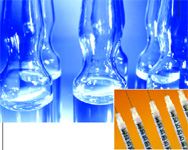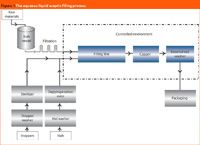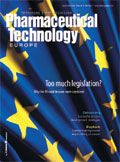The role of media fills in process control
Pharmaceutical Technology Europe
There is currently no vaccination or cure for prion diseases and contamination of a parenteral or infusion pharmaceutical product could prove fatal.
With more pharmaceutical products requiring aseptic processing to ensure end-product sterility, there is increasing emphasis being placed on procedures that demonstrate good process control. For example, stringent cleaning and disinfectant protocols, environmental monitoring, validation of equipment and process simulations (also known as media fill).

The importance of these measures was highlighted in published guidance to the industry, placing even more pressure on manufacturers to show that they are getting it right when it comes to process control and meeting regulatory requirements.1,2
Process simulations are an integral part of the validation/revalidation process and are designed to assess the likelihood of the product becoming microbiologically contaminated during the aseptic manufacturing process.
When performing a media fill, the assumption is made that all other factors that could affect the sterility of the end product — such as the sterility of containers and closures, and the efficiency of the equipment and filtration stages — are satisfactory and validated separately. The results of the media fill trial will simply demonstrate how likely it is for the contamination of units to occur throughout the 'normal' filling process.
For this reason, the trial must simulate the actual process as closely as possible, incorporating all permitted 'contaminating events'. These are events throughout the process that offer the potential for contamination and invariably involve human intervention, such as:
- changing the bulk dose container
- replenishing closures
- replenishing vials
- adjusting the speed of the filling machine
- adjusting the dose volume
- filling machine stoppages
- removing fallen vials
- staff entering or leaving the filling room/shift changes
- microbiological monitoring.
As well as stressing the importance of validating aseptic processes, the new industry guidelines have several important implications for companies performing media fill trials.
Implications of new guidelines
Since the guidelines recommend that process simulations simulate the aseptic filling process as closely as possible, many companies are having to revise the design of their liquid media fills.1 In the past, for liquid fills, the medium would be prepared and sterilized prior to being brought into the filling room and attached to the filling machine using an aseptic connection. However, in the aseptic process, the liquid pharmaceutical product would be placed in a non-sterile bulk container outside the filling room and then filter sterilized, through a filter train, into a sterile bulk container within the filling room. To simulate this process exactly, the medium would have to go through the same filtration step (Figure 1). This raises several concerns, for example

Figure 1 The aqueous liquid aseptic filling process.
- Dehydrated culture media are usually supplied in a non-sterile form and carry a high bioburden (> 104 cfu/g), preventing them from being taken directly into the support clean area where the bulk non-sterile vessel would be.
- For liquid fills, many holding vessels upstream of filtration do not have the capability to heat culture media to an adequate temperature to dissolve the powder into a solution. Even for those that have this ability, the time and energy used in heating and cooling is considerable and costly.
- Mycoplasmas present in the non-sterile dehydrated medium may be able to pass through some filters.
- Broths traditionally used for media fills do not have good filterability characteristics and could block the sterilizing filters before the end of the run. This would invalidate the process simulation and the trial would have to be repeated. Not only is this a waste of time and resources, but it increases the downtime of the filling area with obvious financial implications for the manufacturer.
The new guidelines also recommend an increase in the number of units required to be filled in a process simulation. Run sizes of between 5000 and 10000 units are now recommended (or, if a production run size is less that 5000, the number of media filled units should at least equal the maximum batch size) to demonstrate that aseptic processing is being achieved (< 0.1% contamination with a 95% confidence limit).1
Moreover, the requirement to include all contaminating events, including worst case conditions, may often take the run size to more than 10000 media filled units. This increase in the number of filled units required will, in turn, increase the volume of medium required. If the medium has to be filter sterilized in the simulation process, the volume of medium used (in addition to its filterability) will also have an affect on the life of the filter.
All of these issues must be taken into account when selecting the growth medium to be used in a process simulation.
Three consecutive successful process simulations are required every 6 months for every filling process performed by a pharmaceutical company. By ensuring that the media fill runs smoothly (without delays caused by heating large quantities of medium or blocked filters), the length of time that the production line is out of action can be kept to an absolute minimum.
Choosing the right medium
The most commonly used medium is tryptone soya broth (TSB), also referred to as soybean casein digest medium.1 This is a good, general purpose medium that will support the growth of a wide variety of micro-organisms. TSB has been used by the pharmaceutical industry for many years in process simulations, but with the evolution of trial design to accommodate updated regulatory requirements, many standard TSB products are not able to meet the most recent demands of the industry.
Newer products are now available, however, that address these demands, ensuring a successful trial whilst satisfying the regulatory bodies. The ideal product is an irradiated, cold-filterable TSB with known filterability, for several reasons
- Irradiation of the medium, at a level ≥ 25 kGy, ensures that the dehydrated medium is suitable for use in pharmaceutical clean areas. Irradiation also eliminates the threat of contamination by mycoplasmas.
- It is now possible to obtain cold-filterable TSB that will dissolve in water without heating. Unlike standard TSB products, this medium is highly filterable, reducing the risk of blocked filters during process simulation. Furthermore, since heating is not required to make the medium dissolve or filter, it is more efficient and cost effective and is suitable for use in vessels that do not have heating capability.
- Pharmaceutical companies are now able to obtain irradiated, cold-filterable TSB with a known filterability. The volume of medium able to pass through a filter of a certain pore sizing before the filter blocks, is known as the Vmax or Vcap. For media with a known Vmax, pharmaceutical companies can calculate whether the filter will cope with the total volume of medium required to complete the trial. This will reduce the number of invalid trials because of filter blockages.
Another regulatory concern that affects the choice and source of the culture media is the threat of prion contamination. Prions are infectious agents responsible for a range of neuro-degenerative diseases known as transmissible spongiform encephalopathies (TSEs).
It is known that the human form of the disease, new variant Creutzfeldt-Jakob Disease (nvCJD) can be transmitted from prion contaminated animal material.3 There is currently no vaccination or cure for prion diseases and contamination of a parenteral or infusion pharmaceutical product could prove fatal.4
Many culture media, including TSB, contain components of animal origin — frequently bovine. Prions require specific heat or chemical treatment to be inactivated. Furthermore, there is no in situ method available for the detection of these particles.
It is vitally important that the culture media manufacturer can provide the necessary certifications and documentation to confirm that materials of animal origin are sourced from 'BSE-free' countries to meet regulatory requirements. An alternative approach would be to use a medium derived purely from vegetable materials.
Meat-free alternatives
In response to the issue surrounding materials of animal origin, some culture media manufacturers have developed meat-free media in which components derived from animals are replaced with vegetable-based materials. However, for this media to be a viable alternative for the pharmaceutical industry, they must be able to demonstrate performance characteristics at least equivalent to those of traditional meat-based media.
Conclusion
Although new guidelines and regulations are placing greater demands on pharmaceutical manufacturers to demonstrate process control, the development of culture media is keeping pace to help meet these stringent requirements.
Products such as irradiated, cold-filterable TSB and alternative meat-free media can help pharmaceutical manufacturers to meet these challenges.
Colin Booth is vice president, science and technology at Oxoid Limited, Basingstoke (UK).
References
1. FDA Guidance for Industry — Sterile Drug Products Produced by Aseptic Processing — current Good Manufacturing Practices, 2004 (US Food and Drug Administration 5600 Fishers Lane, Rockville MD 20857-0001, USA).
2. European Commission Guide to Good Manufacturing Practice, Annex 1, Manufacture of Sterile Medicinal Products, 2004 (EMEA, 7 Westferry Circus, Canary Wharf, London, UK).
3. J. Collinge, et al., Nature 383(6602), 685–690 (1996).
5. USDA, CFSAN, Bad Bug Book, 2004. www.cfsan.fda.gov/~mow/prion.html

Drug Solutions Podcast: A Closer Look at mRNA in Oncology and Vaccines
April 30th 2024In this episode fo the Drug Solutions Podcast, etherna’s vice-president of Technology and Innovation, Stefaan De Koker, discusses the merits and challenges of using mRNA as the foundation for therapeutics in oncology as well as for vaccines.
Pharmaceutical Tariffs Are Imminent: How Industry is Bracing for Impact
April 16th 2025On April 14, 2025, the Trump Administration launched a national security-driven investigation into pharmaceuticals, a move that will likely result in tariffs being placed on pharmaceutical drugs, ingredients, and other components that are imported from outside of the United States.